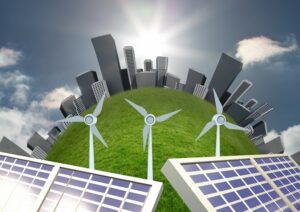
This site attempts to provide a comprehensive review of the state of the art and recent advancements in renewable energy technologies, focusing on solar, wind, nuclear fusion, and other sources. We will discuss cutting-edge innovations, such as perovskite solar cells, airborne wind energy systems, and inertial confinement fusion. These technologies’ environmental impact and potential to revolutionize the global energy landscape are also examined.
The discussion panels are open to your intelligent ideas and comments.
Introduction
The global energy sector is witnessing a paradigm shift driven by technological innovations, environmental concerns, and the urgent need for sustainable solutions. Renewable energy sources, such as solar and wind power, have experienced significant advancements, while nuclear fusion holds promise as a nearly inexhaustible, clean energy source. This article delves into the latest developments in these areas, providing renewable energy experts with an overview of the state-of-the-art technologies shaping the future of energy production.
Solar Energy: Perovskite Solar Cells and Bifacial Panels
Solar energy has experienced rapid growth in recent years thanks to innovations like perovskite solar cells and bifacial solar panels. Perovskite solar cells offer a cost-effective, highly efficient alternative to traditional silicon-based photovoltaic cells. With their tunable bandgaps and impressive power conversion efficiencies, perovskite solar cells have the potential to revolutionize solar power generation.
On the other hand, bifacial solar panels capture sunlight on both sides, harnessing reflected and diffused light from their surroundings. This results in increased energy production and system efficiency, making bifacial panels an attractive option for utility-scale solar installations
Developing solar tracking systems, concentrating solar power (CSP) technology, and bifacial solar panels have increased efficiency, allowing solar energy to maintain its competitive edge in the renewable energy market. Furthermore, integrating solar panels into building materials, known as building-integrated photovoltaics (BIPV), has broadened the scope of solar energy applications.
Wind Energy: Airborne Wind Energy Systems and Floating Offshore Wind Farms
Wind energy technology has also seen significant advancements, including the development of airborne wind energy systems (AWES) and floating offshore wind farms. AWES, which utilizes tethered kites, balloons, or drones to harness high-altitude winds, offers the potential for increased energy generation at lower costs than traditional wind turbines.
Meanwhile, Floating offshore wind farms allow wind turbines to be installed in deep waters, where wind speeds are generally higher and more consistent. This technology can significantly expand the geographical reach of wind energy, offering vast untapped potential for global energy production.
Moreover, exploring high-altitude wind energy and using advanced materials, such as carbon fiber composites, have increased wind turbines’ efficiency and structural integrity. Additionally, innovative offshore wind technologies, such as floating wind turbines and vortex-induced vibrations for aquatic biomimetic energy (VIVACE) converters, have unlocked new potential for wind power generation in deep waters.
Nuclear Fusion: Inertial Confinement Fusion and Tokamak Reactors
Nuclear fusion, the process that powers stars, is emerging as a game-changing technology with the potential to provide a virtually inexhaustible and clean energy source. Inertial confinement fusion (ICF) is an approach that utilizes high-powered lasers or particle beams to compress and heat a fuel pellet, initiating fusion reactions. The National Ignition Facility in the United States and the Laser Megajoule in France are among the leading ICF research centers.
Tokamak reactors, another fusion technology, employ magnetic fields to confine plasma in a toroidal shape, maintaining the high temperatures and pressures necessary for fusion. ITER, an international collaboration currently under construction in France, is the world’s largest tokamak reactor and aims to demonstrate the feasibility of fusion as a large-scale, safe, and environmentally friendly energy source.
Environmental Impact and Global Energy Landscape
Adopting advanced renewable energy technologies can significantly reduce greenhouse gas emissions, helping mitigate climate change and its devastating effects. Solar and wind power, for example, generate electricity with virtually no emissions, while nuclear fusion produces only helium as a byproduct, eliminating the issue of long-lived radioactive waste.

Harnessing Ocean Energy
The ocean energy sector has been making strides in tapping the vast potential of wave, tidal, and ocean current energy. Cutting-edge wave energy converters (WECs) have been developed to capture the kinetic energy of ocean waves, with technologies such as oscillating water columns (OWCs), point absorbers, and attenuators leading the way.
Similarly, innovations in tidal energy technologies, including tidal stream turbines and lagoons, have enabled efficient harnessing of the immense energy contained in tidal fluctuations. The ocean thermal energy conversion (OTEC) technology is also a promising approach for generating renewable energy by exploiting the temperature difference between warm surface water and cold deep water.
Advanced Bioenergy and Geothermal Solutions
Bioenergy has made significant progress, with breakthroughs in producing advanced biofuels, such as cellulosic ethanol and algae-based biofuels. These innovations have paved the way for sustainable and efficient alternatives to fossil fuels in the transportation sector.
The geothermal industry has evolved with the development of enhanced geothermal systems (EGS) and advanced drilling technologies, which have expanded the range of geothermal resources that can be exploited. Additionally, the introduction of closed-loop geothermal systems has minimized environmental impacts and improved the overall efficiency of geothermal power plants.
Innovative Energy Storage Solutions
The growth of renewable energy sources has increased the need for advanced energy storage systems. Breakthroughs in energy storage technologies, such as solid-state batteries, flow batteries, and liquid metal batteries, offer higher energy density, longer cycle life, and improved safety compared to conventional batteries.
Furthermore, advancements in compressed air energy storage (CAES), pumped hydro storage (PHS), and hydrogen-based storage systems have provided large-scale energy storage solutions, ensuring the stability and reliability of the renewable energy grid.
Integration of Artificial Intelligence (AI) and IoT in Renewable Energy Systems
Integrating AI and the Internet of Things (IoT) into renewable energy systems has revolutionized how energy is generated, distributed, and managed.